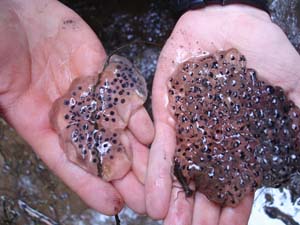PEC’s Sustainable Habitat Program Manager, James Barnes, wrote this article about our region’s amphibians for the Spring 2012 issue of The Piedmont Virginian…
The History & Habitat of Amphibians
By James Barnes
Our most ostentatious spring migrants – the birds – garner the most attention with their showy plumage, vocals, and courtships. However, birds are not the only species that “return” to the Piedmont. Spring also marks the return of another class of creatures: the amphibians. In common with the beautiful scarlet tanager which travels from South America, these under-appreciated animals undertake dramatic journeys to reach their specialized breeding grounds and food. Learning more about them and their needs opens up a whole new perspective on what constitutes “wildlife” and “habitat”.

Amphibians include the frogs/toads, salamanders, and caecilians (found in tropical climates). They usually have moist skin, no claws, and reproduce underwater. These are guidelines with quite a few exceptions, however. For example, Red-backed Salamanders don’t require water to breed and Eastern Newts can have dry skin – both are small salamanders found in the Piedmont. In general, amphibians are pretty distinctive creatures and you know one when you see, hear, or feel it.
There are over 30 amphibians that occur in the Piedmont of Virginia. This diversity ranges from the tiny, common frog called the Spring Peeper (with its distinctive and very familiar early spring “Peeper” call), to the endangered Shenandoah Salamander which is found in Shenandoah National Park and nowhere else in the world. All of our amphibians share one common challenge – winter. Unlike birds and retirees, amphibians cannot leave for Florida during months with subfreezing temperatures. And similar to reptiles, they are exothermic, which means they can’t regulate their temperature like mammals and birds. So instead they migrate downward, beneath earth and water where they hibernate using different strategies. Some, such as the Wood Frog, burrow very shallowly under leaf litter and are actually able to freeze. If you’re lucky, you might come across one frozen solid in midwinter.
Most of our amphibians meet winter’s challenge by migrating from their wetland breeding grounds to drier uplands where they burrow. Refuting a common misconception, the majority of our frogs and salamanders spend more time on land than in water! For them, water is principally a place to reproduce and lay eggs. Underground they hibernate for months, waiting for the cue to return — warm, rainy nights with above freezing temperatures. In early spring, they awaken from their hibernation and migrate downhill to wetlands in search of mates.

The Spotted Salamander (see picture) is one of the first to make this journey, which can be over half a mile. This may not seem far, but considering their small size and clumsy locomotion, it is quite impressive. Like many other species, Spotted Salamanders migrate to small ephemeral pools of water (woodland vernal pools), which are free of fish and other predators because they dry up in the summer. Here amphibians can safely mate and lay eggs. After a short few weeks, the adults leave the pools and return to burrow in the uplands and are rarely seen again till next spring. Predictably, adults return year after year to the same vernal pools.
Unfortunately, many of our amphibians are experiencing serious decline, largely due to habitat loss. You can help in several ways. If you’re a landowner, survey for vernal pools on your property. You’ll know it’s an active pool if there are egg masses (see picture). Leave or add more downed stems and twig along the edge of the pool since many amphibians lay their sticky eggs on these. If possible, designate a 100-foot buffer (at a bare minimum) in the wooded area around the pool where little human disturbance is allowed. For the more intrepid, it’s possible to create an artificial vernal pool – assuming you have the right land-use, topography, and hydrology; contact an expert for more information.
You can also help by volunteering on a “big night”. Big nights occur early in the season when weather conditions are optimal and many frogs and salamanders make the journey from upland to wetland. It’s not uncommon to see hundreds of these little creatures making the crossing within a few hours. However, traffic presents a particular hazard for amphibians because roads often bisect wetlands and uplands, and road kill can be quite high on “big nights”. Groups such as the Virginia Herpetological Society and the Loudoun Wildlife Conservancy help by slowing traffic and physically moving amphibians on these critical nights. These are very fun evenings and great for kids who rarely get to touch (and help) wildlife.
Image Credit: James Barnes
Caption 1: Spotted Salamander
Caption 2: A Spotted Salamander egg mass is one globular mass, while Wood Frog eggs are independent globs.
